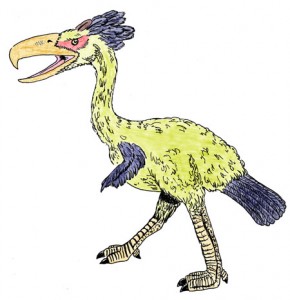Dinosaur Extinction Event led to Evolution of Flightless Birds
An abundance of food in conjunction with relatively few, large ground-dwelling predators led some types of bird to give up flying and take to a wholly terrestrial, flightless existence according to a team of Australian researchers.
In a new study into the origins of flightless birds such as Emus, Rheas, Moas and Ostriches led by Dr Matthew Phillips, an ARC Postdoctoral Fellow at the Australian National University Research School of Biology, it seems that these birds became flightless independently and did not share a flightless common ancestor. Surprisingly, the researchers, after examining the mitochondrial genome sequences of the now-extinct giant Moa birds of New Zealand; have suggested that these colossal creatures are most closely related to small flying birds native to South America.
The team used assessments of the mitochondrial DNA of extant and extinct flightless birds, their study concluded that the ancestors of the African Ostrich, Australasian Emu plus the Cassowary, South American Rheas and New Zealand Moa became flightless independently, in close association with the extinction of the dinosaurs about 66 million years ago.
Commenting on the results from this new study, Dr Phillips stated:
“Many of the world’s largest flightless birds, known as Ratites, were thought to have shared a common flightless ancestor. We followed up on recent uncertainty surrounding this assumption.”
He went onto add:
“Our study suggests that the flighted ancestors of Ratites appear to have been ground-feeding birds that ran well. So the extinction of the Dinosaurs likely lifted predation pressures that had previously selected for flight and its necessary constraint, small size. Lifting of this pressure and more abundant foraging opportunities would then have selected for larger size and consequent loss of flight.”
The demise of the dinosaurs, particularly the theropod predators, ironically those dinosaurs believed to be most closely related to birds, permitted the diversity of Aves, leading to the development of a number of flightless bird types.
When Sir Richard Owen, the founder of the Natural History Museum in London and the scientist credited with first coining the phrase “Dinosauria”, was photographed next to the giant bones of a Moa bird from New Zealand, he was not aware that the dinosaur’s demise may have led to existence of such creatures.
An Illustration of a Giant, Flightless Bird (Kelenken)
The finding of independent origins of flightlessness also solves a mystery of how these flightless birds dispersed across the world over marine barriers, their ancestors simply flew across them.
Dr Phillips stated that previous research had indicated that Ratite birds were thought to be relics from the super-continent Gondwanaland, which consisted of South America, Australia, India, Africa, New Zealand and Antarctica, all elements of the Southern Hemisphere. This new study suggests that separate Ratites evolved too recently to have had a common ancestor on Gondwanaland before the super-continent broke up. The study also reveals that today’s flightless birds may have had their origins in the Northern Hemisphere.
Dr Phillips said:
“Not only have we shown that the separate Ratite lineages evolved too recently to have been on Gondwana before its continents drifted apart, but from our analyses we infer that at least ostriches, and possibly Ratites as a whole, have their origins in the northern continents.”
The research paper is published in the scientific journal “Sytematic Biology”, certainly there is something very intimidating when up close to birds like ostriches as they tower over your head. They have quizzical jerky movements and when they fix you with a stare it is quite frightening. However, if you want to see evidence of how closely related birds are to dinosaurs simply take a look at their feet. The feet are very reminiscent of the feet of a theropod dinosaur and they are very reptilian in appearance.
For models of dinosaurs and also extinct, flightless birds: CollectA Deluxe Prehistoric Life Models.







Leave A Comment